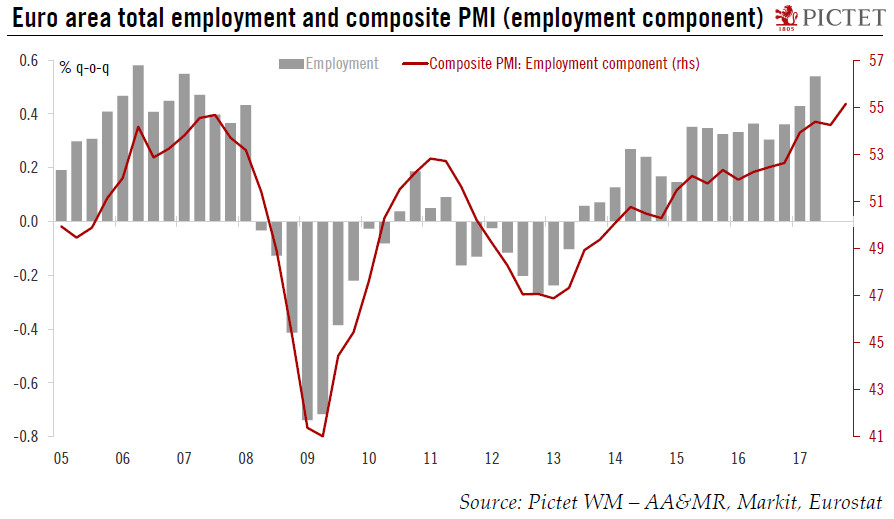Leading indicators point to an acceleration in already strong job creation in the quarters ahead.Recent economic crises took a heavy toll on the employment level in the euro area, with almost five years of uninterrupted employment losses. Between its pre-crisis peak in the first quarter of 2008 and the second quarter of 2013, euro area employment levels fell by 3.6%, or more than 5.5 million.However, since hitting a low point in the second quarter of 2013, euro area employment has shown continued quarter-on-quarter expansion posting a total increase of 6.8 million. The continued employment growth seen across the euro area has been stronger than expected. The gap with the pre-crisis level (2008) closed in Q1 2017 and employment is now 1% above its pre-crisis level.One development of note
Topics:
Nadia Gharbi considers the following as important: euro area composite PMI, Euro area employment, euro area labour market, Macroview
This could be interesting, too:
Cesar Perez Ruiz writes Weekly View – Big Splits
Cesar Perez Ruiz writes Weekly View – Central Bank Halloween
Cesar Perez Ruiz writes Weekly View – Widening bottlenecks
Cesar Perez Ruiz writes Weekly View – Debt ceiling deadline postponed
Leading indicators point to an acceleration in already strong job creation in the quarters ahead.

Recent economic crises took a heavy toll on the employment level in the euro area, with almost five years of uninterrupted employment losses. Between its pre-crisis peak in the first quarter of 2008 and the second quarter of 2013, euro area employment levels fell by 3.6%, or more than 5.5 million.
However, since hitting a low point in the second quarter of 2013, euro area employment has shown continued quarter-on-quarter expansion posting a total increase of 6.8 million. The continued employment growth seen across the euro area has been stronger than expected. The gap with the pre-crisis level (2008) closed in Q1 2017 and employment is now 1% above its pre-crisis level.
One development of note is that employment growth has been broadly spread, including many countries that were hard hit by the crisis. As an example, Spain has contributed more than one quarter to the increase in euro area employment, albeit mostly from temporary contracts. At a sectoral level, job gains have been mainly concentrated in services, but encouraging signs can be seen in job creation in the construction since the beginning of the year.
Looking ahead, leading indicators such as the employment component of the composite purchasing managers’ index (PMI) point to an acceleration in rises in employment, creating some upside risks for our GDP forecasts. A better labour market, coupled with moderate inflation and still-accommodative monetary policy, will remain a key support for private consumption, one of the main pillars of the euro area economy.
